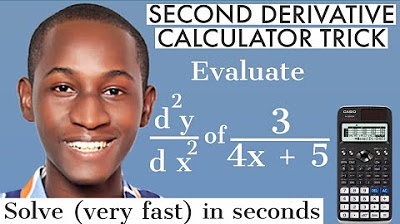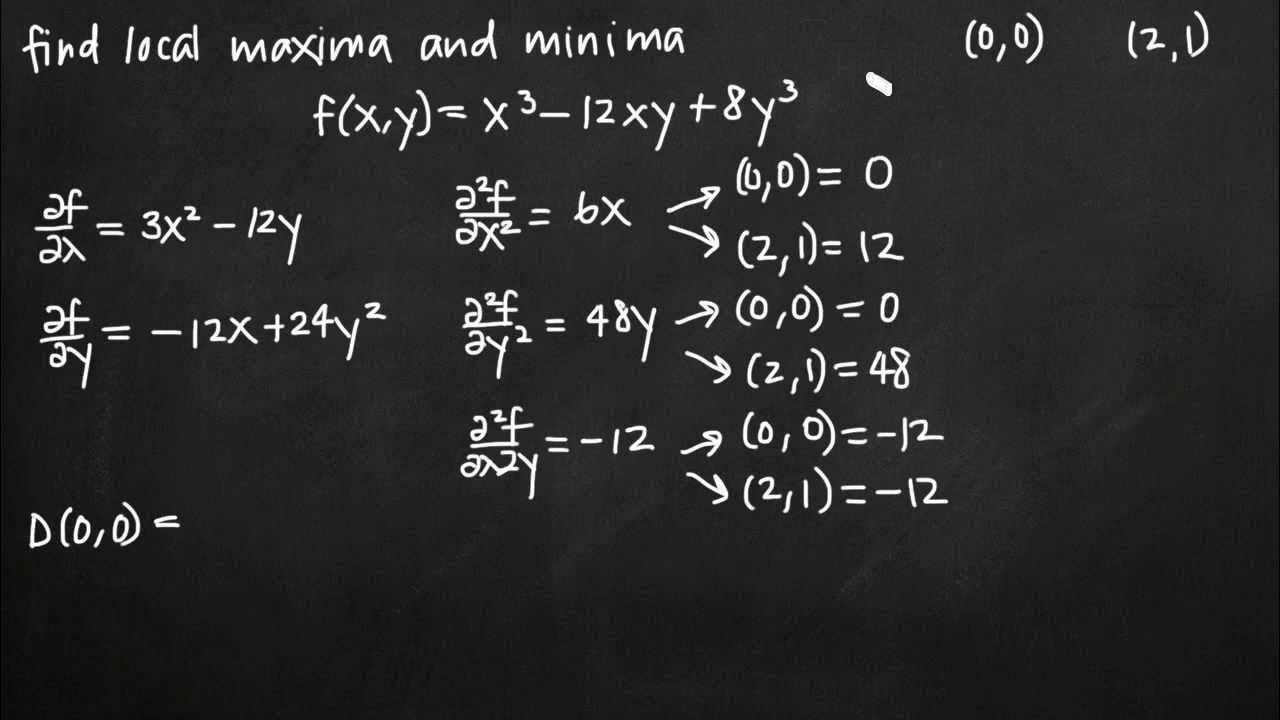2nd Derivative + Radius of Curvature Calculator Techniques | Engineering Board exam | Yu Jei Abat
TLDRThis video script focuses on teaching viewers how to find the second derivative of a function using calculator techniques, specifically for engineering board exams. The presenter explains the formula for approximating the second derivative, \( f''(x) = \frac{f'(x_2) - f'(x_1)}{x_2 - x_1} \), where \( x_1 = 0.1 \) and \( x_2 = 0.1 + 10^{-5} \). The script guides through several examples, including calculating the second derivative of functions like \( y = x \ln(x) \) and applying the concept to find the radius of curvature for a parabola and an ellipse. The presenter emphasizes setting the calculator to radian mode for transcendental functions and demonstrates step-by-step calculations, comparing the results with multiple-choice answers to identify the correct one. The script concludes with an assignment for the viewers to find the second derivative of a given function and hints at the answer being option A. The video is an educational resource for those preparing for exams and looking to enhance their understanding of calculus and its applications.
Takeaways
- 📚 Start by understanding the formula for approximating the second derivative: f''(x) = (f'(x₂) - f'(x₁)) / (x₂ - x₁), where x₁ is a chosen value and x₂ is x₁ plus a small increment.
- 🔢 Set your calculator to function mode to handle transcendental functions, which is usually done by pressing shift, set up, and then 4.
- 📈 For the first derivative (f'(x₁)), input the function and evaluate it at x = 0.1, then store the result in a variable, for example, variable A.
- 📉 To find the second derivative (f'(x₂)), add a small increment (1 * 10^(-5)) to the x value used for the first derivative and store the result in another variable, for example, variable B.
- ➗ Apply the second derivative formula by dividing the difference between the values in variables A and B by the small increment (1 * 10^(-5)) to get an approximation of the second derivative.
- 🔑 Use the second derivative to solve problems, such as finding the radius of curvature, by substituting the appropriate values into the given formulas.
- 🧮 When dealing with specific x values, use those values directly in the derivative calculations instead of the approximation method.
- 📐 For the radius of curvature, use the formula R = (1 + (dy/dx)²)^(3/2) / |d²y/dx²|, where dy/dx is the first derivative and d²y/dx² is the second derivative.
- 🔍 When comparing answers to multiple-choice questions, substitute the given x value into each choice and compare it to the calculated second derivative to find the closest match.
- 📝 Keep in mind that the second derivative can also be used to analyze the concavity and inflection points of a function.
- 📋 Store intermediate results in calculator variables for easy reference and to avoid recalculating the same values.
- 🔬 Practice applying these techniques to various problems to become proficient in using a calculator for calculus problems.
Q & A
What is the main topic of the video?
-The main topic of the video is discussing calculator techniques for finding the second derivative in the context of an engineering board exam.
What formula is used to approximate the second derivative?
-The formula used to approximate the second derivative is f''(x) = (f'(x_2) - f'(x_1)) / (x_2 - x_1), where x_1 is set to 0.1 and x_2 is x_1 plus 1 times 10 to the power of negative 5.
How do you set the calculator to the correct mode for this task?
-To set the calculator to the correct mode, you use the 'shift', 'set up', and then '4' for the 'reg' or 'region' mode, which is suitable for derivatives involving transcendental functions.
What is the first function the video demonstrates finding the second derivative for?
-The first function demonstrated is y = x * ln(x), where ln(x) represents the natural logarithm of x.
What is the process for finding the second derivative of a function using the given formula?
-The process involves calculating the first derivative at two points, x_1 and x_2, where x_2 is x_1 plus a small increment (1 * 10^-5), and then using these values to apply the formula for the second derivative.
How does the video demonstrate the application of the second derivative?
-The video demonstrates the application of the second derivative by showing how to calculate the radius of curvature for a parabola and an ellipse.
What is the formula for the radius of curvature?
-The formula for the radius of curvature is given by R = (1 + ((dy/dx)^2))^(3/2) / |d^2y/dx^2|, where dy/dx is the first derivative and d^2y/dx^2 is the second derivative.
How does the video ensure the equation is purely in terms of y before differentiating?
-The video ensures the equation is purely in terms of y by taking the square root of both sides if necessary, to isolate y on one side of the equation.
What is the method to compare the calculated second derivative with the given choices?
-The method involves substituting a specific value of x into the given choices, calculating the result, and then comparing it to the stored value of the second derivative (variable c) to determine which choice is approximately equal to 1.
What is the significance of the small increment added to x_1 to find x_2?
-The small increment (1 * 10^-5) added to x_1 to find x_2 is used to provide a slight variation in the x-value for the purpose of calculating the second derivative, which is an approximation technique.
How does the video use the calculator to store and recall values?
-The video demonstrates using the 'shift' and 'RCL' (Recall) functions on the calculator to store intermediate results in variables A, B, and C, and then recall these stored values as needed during the calculation process.
What is the final advice given to the viewers regarding the second derivative calculation?
-The final advice is to practice applying the calculator techniques for finding the second derivative and to understand its applications, such as in calculating the radius of curvature, for the engineering board exam.
Outlines
📚 Introduction to Second Derivative Calculation
This paragraph introduces the topic of calculating the second derivative using a calculator. The presenter explains the formula for the second derivative, which involves finding the derivative at two points, x1 and x2, and then using these values to approximate the second derivative. X1 is set to 0.1, and x2 is x1 plus a small increment. The presenter emphasizes the importance of setting the calculator to the correct mode for handling transcendental functions and provides a step-by-step guide on how to input and calculate the derivative of a function, y = x ln(x), using the calculator.
🔍 Approximating Second Derivatives with Calculator Techniques
The second paragraph focuses on using an approximation formula to find the second derivative. The presenter demonstrates how to calculate the second derivative of a function and compare it with multiple-choice answers to identify the correct one. The process involves substituting the value of x into the function and comparing the result with the approximation obtained from the calculator. The presenter also shows how to adjust the calculator for different problems, including those with specific x values and those that require differentiation at a given point.
🎢 Calculating the Second Derivative of a Cubic Function
In this paragraph, the presenter tackles the second derivative of a cubic function. The unique aspect of this problem is that it involves a constant value for x when evaluating the second derivative. The presenter inputs the function into the calculator and uses the value x = 1 to find the second derivative. The process includes calculating the first derivative, storing intermediate results, and applying the formula for the second derivative. The presenter then compares the calculator's result with the given choices to determine the correct answer.
🧮 Derivatives and Radius of Curvature
The fourth paragraph discusses the application of second derivatives in calculating the radius of curvature. The presenter explains the formula for the radius of curvature and how it involves both the first and second derivatives of a function. The presenter demonstrates this by finding the radius of curvature for a parabola at a given point. The process requires expressing the equation in terms of y, calculating the first and second derivatives, and then applying the formula for the radius of curvature. The presenter also shows how to use the calculator to find the correct answer from the given choices.
🚀 Advanced Applications of Second Derivatives
The final paragraph covers more advanced applications of second derivatives, including calculating the radius of curvature of an ellipse and differentiating complex functions. The presenter demonstrates the process of expressing an equation in terms of y, calculating the first and second derivatives, and then using these values to find the radius of curvature. The presenter also provides a problem involving a complex function and guides the viewer through the differentiation process, including calculating the second derivative and comparing the result with given choices to find the correct answer.
Mindmap
Keywords
💡Second Derivative
💡Calculator Techniques
💡Engineering Board Exam
💡Transcendental Functions
💡Approximation
💡Curvature
💡First Derivative
💡Function Evaluation
💡Variable Storage
💡Radius of Curvature Formula
💡Differentiation
Highlights
The video discusses techniques for finding the second derivative using calculator methods.
The formula for approximating the second derivative is introduced: f''(x) = (f'(x₂) - f'(x₁)) / (x₂ - x₁), with x₁ = 0.1 and x₂ = 0.1 + 1e-5.
The importance of setting the calculator to radian mode for transcendental functions is emphasized.
An example of finding the second derivative of y = x * ln(x) is demonstrated step by step.
The process involves storing intermediate results in calculator variables for ease of calculation.
Comparing calculated values with multiple-choice options to find the closest approximation to 1, indicating the correct answer.
Differentiation of more complex functions, such as 8x^4 + 5αx^3 - αx^2 + 7, is shown using the same technique.
The video provides a method to find the second derivative at a specific point, given a value for x, as in the case of x = 1 for the function 2x + 3(4x + 2)^3.
The concept of the radius of curvature and its formula are introduced, with an example problem involving a parabola.
The process of converting an equation to a form purely in terms of y before differentiation is explained.
An example calculation of the radius of curvature for an ellipse at a given point is demonstrated.
The video concludes with a problem involving the second derivative of an exponential function combined with a logarithmic function.
The use of the calculator to approximate and compare answers to multiple-choice options is a recurring theme throughout the video.
The video emphasizes the practical application of second derivatives, such as in calculating the radius of curvature in geometry.
The presenter provides a step-by-step guide, making complex calculus concepts more accessible.
The video concludes with an assignment for the viewer to practice finding the second derivative of a given function.
Throughout the video, the presenter encourages viewers to learn and apply the techniques for solving second derivatives using calculators.
Transcripts
Browse More Related Video

Third Derivative Calculator Technique For ENGINEERING BOARD EXAM | ENGR. YU JEI ABAT | #ABATANDCHILL

FAST STEPS TO SOLVE SECOND DERIVATIVE USING CALCULATOR: fx-991 ex | double differentiation

Higher Order Derivatives

2023 AP Calculus BC FRQ #6

Local extrema and saddle points of a multivariable function (KristaKingMath)

2014 AP Calculus AB Free Response #5
5.0 / 5 (0 votes)
Thanks for rating: